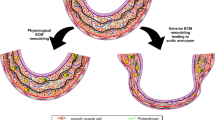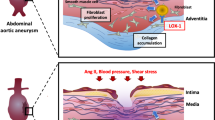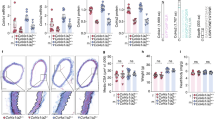Abstract
The molecular mechanisms predisposing to atherosclerotic aneurysm formation remain undefined%1,5. Nevertheless, rupture of aortic aneurysms is a major cause of death in Western societies, with few available treatments and poor long-term progno–sis. Indirect evidence suggests that matrix metalloproteinases (MMPs) and plasminogen activators (PAs) are involved in its pathogenesis%1,6–12. MMPs are secreted as inactive zymogens (pro-MMPs), requiring activation in the extracellular compartment%11,13. Plasmin, generated from the zymogen plasminogen by tissue-type plasminogen activator (t-PA) or urokinase-type plas-minogen activator (u-PA; refs 14,15), has been proposed as a pos–sible activator in vitro, but evidence for such a role in vivo is lacking%16,17. Analysis of atherosclerotic aorta in mice with a deficiency of apoliprotein E (Apoe−/− ref. 18), singly or combined with a deficiency of t-PA (Apoe−/−.PIar−/−) or of u-PA (Apoe−/−-iPlair−/−, ref. 19), indicated that deficiency of u-PA protected against media destruction and aneurysm formation, probably by means of reduced plasmin-dependent activation of pro-MMPs. This genetic evidence suggests that plasmin is a pathophysiologically signifi–cant activator of pro-MMPs in vivo and may have implications for the design of therapeutic strategies to prevent aortic-wall destruction by controlling Plau gene function.
This is a preview of subscription content, access via your institution
Access options
Subscribe to this journal
Receive 12 print issues and online access
$209.00 per year
only $17.42 per issue
Buy this article
- Purchase on Springer Link
- Instant access to full article PDF
Prices may be subject to local taxes which are calculated during checkout
Similar content being viewed by others
References
Anidjar, S. & Kieffer, E. Pathogenesis of acquired aneurysms of the abdominal aorta. Ann. Vase. Surg. 6, 298–305 (1992).
Braverman, A.C. Penetrating atherosclerotic ulcers of the aorta. Curr. Opin. Cardiol. 9, 591–597 (1994).
Macsweeney, ST., Powell, J.T & Greenhalgh, R.M. Pathogenesis of abdominal aortic aneurysm. Br. J. Surg. 81, 935–941 (1994).
Halloran, B.C. & Baxter, B.T. Pathogenesis of aneurysms. Semin. Vase. Surg. 8, 85–92 (1995).
Patel, M.I., Hardman, D.T., Fisher, C.M. & Appleberg, M. Current views on the pathogenesis of abdominal aortic aneurysms. J. Am. Coll. Surg. 181, 371–382 (1995).
Libby, P. Molecular basis of the acute coronary syndromes. Circulation 91, 2844–2850 (1995).
Schneiderman, J. et al. Expression of fibrinolytic genes in atherosclerotic abdominal aortic aneurysm wall: a possible mechanism for aneurysm expansion. J. Clin. Invest. 96, 639–645 (1995).
Newman, K.M. et al. Cellular localization of matrix metalloproteinases in the abdominal aortic aneurysm wall. J. Vase. Surg. 20, 814–820 (1994).
Halpert, I. et al. Matrilysin is expressed by lipid-laden macrophages at sites of potential rupture in atherosclerotic lesions and localizes to areas of versican deposition, a proteoglycan substrate for the enzyme. Proc. Natl. Acad, Sd. USA 93, 9748–9753 (1996).
Lupu, F. et al. Plasminogen activator expression in human atherosclerotic lesions. Arteriosder. Thromb. Vase. Biol. 15, 1444–1455 (1995).
Dollery, CM., McEwan, J.R., & Henney, A.M. Matrix metalloproteinases and cardiovascular disease. Ore. Res. 77, 863–868 (1995).
Galis, Z.S., Sukhova, G.K., Lark, M.W. & Libby, P. Increased expression of matrix metalloproteinases and matrix degrading activity in vulnerable regions of human atherosclerotic plaques. J. Clin. Invest. 94, 2493–2503 (1994).
Murphy, G. Matrix metalloproteinases and their inhibitors. Acta Orthop. Scand. (Suppl. 256) 66, 55–60 (1995).
Collen, D. & Lijnen, H.R. Basic and clinical aspects of fibrinolysis and thrombolysis. Blood. 78, 3114–3124 (1991).
Carmeliet, P. & Collen, D. Gene manipulation and transfer of the plasminogen system and coagulation system in mice. Semin. Thromb. Hemostasis 22, 525–542 (1996).
Murphy, G., Atkinson, S., Ward, R., Gavrilovic, J. & Reynolds, J.J. The role of plasminogen activators in the regulation of connective tissue metalloproteinases. Ann. NY Acad. Sd. 667, 1–12 (1992).
Eeckhout, Y. & Vaes, G. Further studies on the activation of procollagenase, the latent precursor of bone collagenase. Biochem. J. 166, 21–31 (1977).
Plump, A.S. et al. Severe hypercholesterolemia and atherosclerosis in apolipoprotein E-deficient mice created by homologous recombination in ES cells. Cell 71, 343–353 (1992).
Carmeliet, P. et al. Physiological consequences of loss of plasminogen activator gene function in mice. Nature 368, 419–424 (1994).
Johnston, K.W. et al. Suggested standards for reporting on arterial aneurysms. Subcommittee on Reporting Standards for Arterial Aneurysms, Ad Hoc Committee on Reporting Standards, Society for Vascular Surgery and North American Chapter, International Society for Cardiovascular Surgery. J. Vase. Surg. 13, 452–458 (1991).
Shapiro, S.D., Kobayashi, D.K. & Ley, T.J. Cloning and characterization of a unique elastolytic metalloproteinase produced by human alveolar macrophages. J. Biol. Chem. 269, 23824–23829 (1993).
Murphy, G., Cockett, M.D., Ward, R.V. & Docherty, A.J.P. Matrix metalloproteinase degradation of elastin, type IV collagen and proteoglycan: a quantitative comparison of the activities of 95 kDa and 72 kDa gelatinases, stromelysins-1 and -2 and punctuated metalloproteinase (PUMP). Biochem. J. 277, 277–279 (1991).
Werb, Z., Banda, M.J. & Jones, P.A. Degradation of connective tissue matrices by macrophages: I. Proteolysis of elastin, glycoproteins, and collagen by proteinases isolated from macrophages. J. Exp. Med. 152, 1340–1357 (1980).
Coussens, L.M. & Werb, Z. Matrix metalloproteinases and the development of cancer. Chem. Biol. 3, 895–904 (1996).
Paigen, B., Morrow, A., Holmes, P.A., Mitchell, D. & Williams, R.A. Quantitative assessment of atherosclerotic lesions in mice. Atherosclerosis 68, 231–240 (1987).
Shipley, J.M., Wesselschmidt, R.L., Kobayashi, O.K., Ley, T.J. & Shapiro, S.D. Metalloelastase is required for macrophage-mediated proteolysis and matrix invasion in mice. Proc. Natl. Acad. Sd. USA 93, 3942–3946 (1996).
Carmeliet, P. et al. Urokinase-type but not tissue-type plasminogen activator mediates arterial neointima formation in mice. Circ. Res. 81, 829–839 (1997).
Delaisse, J. et al. (Pro)collagenase (matrix metalloproteinase-1) is present in rodent osteoclasts and in the underlying bone-resorbing compartment. J. Cell Sd. 106, 1071–1082 (1993).
Senior, R.M., Connelly, N.L., Cury, J.D., Welgus, H.G. & Campbell, E.J. Elastin degradation by human alveolar macrophages: a prominent role of metalloproteinase activity. Am. Rev. Respir. Dis. 139, 1251–1256 (1989).
Author information
Authors and Affiliations
Rights and permissions
About this article
Cite this article
Carmeliet, P., Moons, L., Lijnen, R. et al. Urokinase-generated plasmin activates matrix metalloproteinases during aneurysm formation. Nat Genet 17, 439–444 (1997). https://doi.org/10.1038/ng1297-439
Received:
Accepted:
Issue Date:
DOI: https://doi.org/10.1038/ng1297-439
This article is cited by
-
LOX-1 deficiency increases ruptured abdominal aortic aneurysm via thinning of adventitial collagen
Hypertension Research (2023)
-
Aortic Wall Inflammation in the Pathogenesis, Diagnosis and Treatment of Aortic Aneurysms
Inflammation (2022)
-
The Plasminogen Activator System, Glucocorticoid, and Mineralocorticoid Receptors in the Primate Endometrium During Artificial Menstrual Cycles
Reproductive Sciences (2022)
-
uPARAP/Endo180: a multifaceted protein of mesenchymal cells
Cellular and Molecular Life Sciences (2022)
-
Fluid flow exposure promotes epithelial-to-mesenchymal transition and adhesion of breast cancer cells to endothelial cells
Breast Cancer Research (2021)



